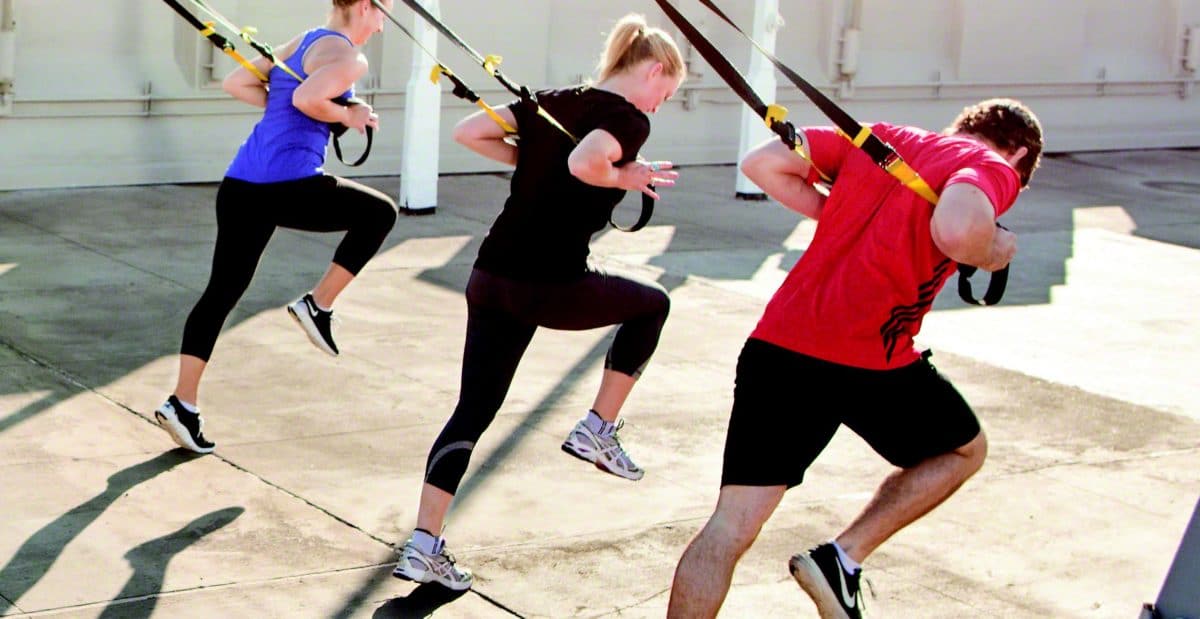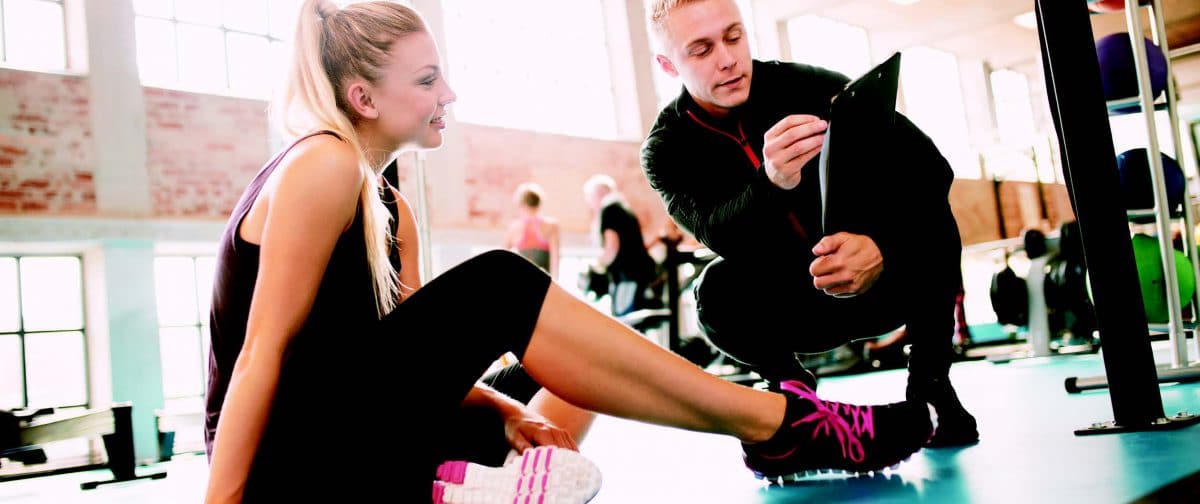ACE Insight
RESEARCH: Investigating The Physiological Responses To Trx® Suspension Training.®
How Effectively Does The Trx Suspension Trainer™ Deliver Short- And Long-Term Health Benefits?
In the past decade, the TRX Suspension Trainer has become an incredibly popular piece of fitness equipment in studios around the world. The manufacturer, along with the equipment’s many proponents, have claimed it provides a variety of workouts that improve mobility and flexibility, build lean muscle and improve core stability.
The Study
Researchers recruited 16 healthy, physically active men and women (21–71 years of age), all of whom were considered low-to-moderate risk for cardiovascular disease.
The first part of the study was a 60-minute class, which was used to quantify each individual’s acute cardiovascular and metabolic response to TRX Suspension Training.
The second part was designed to clarify the benefits over a highly varied, 8-week training program consisting of three 60-minute sessions per week. Before and after the 8 weeks, participants underwent a variety of measurements to determine maximal heart rate, maximal oxygen uptake (VO2max), resting blood pressure, body composition, fasting blood lipids, blood glucose and waist circumference. In addition, participants were evaluated on muscular, neuromotor and flexibility fitness.
The Results
During the 60-minute session, participants burned an average of nearly 400 calories, which is at the upper reaches of the 150–400 calories recommended by industry guidelines (ACSM 2014).
The training study showed positive effects on body composition and cardiovascular health, as demonstrated through significant decreases in waist circumference, body fat percentage, resting systolic blood pressure and resting diastolic blood pressure.
There were also significant improvements in muscular strength and endurance. According to Dr. Dalleck, these improvements, “if they are maintained long term, have been linked to the prevention of cardiovascular disease, diabetes and [early] mortality.” In addition, the reduction in resting blood pressure was significant, with “more dramatic results than are typically seen with traditional aerobic exercise,” he noted.
The only area where participants didn’t see a substantial improvement was in their VO2max, though this may have been because they were relatively fit at baseline.
The Bottom Line
TRX Suspension Training produces strong metabolic responses that meet guidelines for improving and maintaining cardiorespiratory fitness, increasing muscular fitness and positively affecting cardiometabolic-disease risk factors.
Reference
American College of Sports Medicine. 2014. ACSM’s Guidelines for Exercise Testing and Prescription (9th ed.). Philadelphia: Wolters Kluwer/Lippincott Williams.
SPOTLIGHT A PRO:Julie Toyama
Ace Certified Group Fitness Instructor Adelaide, Australia
“Encouraging People To Move In Whatever Way Feels Comfortable, And Then Watching Them Depart From Their Comfort Zone, Has Been Truly Inspiring.”
Q&A with Julie
What inspired you to start a career in fitness?
I’ve been fortunate to have two starts to my fitness career. For the first 15 years, I taught a variety of mainstream group fitness formats. My second start involved shifting my focus to mindful movement. I began encouraging class participants to immerse themselves in their own exploratory workout to meet their individual needs. Teaching mindful movement classes that cater to all fitness levels and ages has proved to be a unique challenge; however, encouraging people to move in whatever way feels comfortable, and then watching them depart from their comfort zone, has been truly inspiring.
What do you love most about your job?
I love watching people get well and experience less pain through movement. I also thrive on providing potentially life-changing experiences that inspire a commitment to prioritize health and well-being.
Which client are you most proud of?
I teach a group of young adults who have mental disorders and illnesses. I work with a man in his early 20s who has Asperger syndrome with significant mental, physical and social challenges. It’s been so rewarding to watch him become stronger, fitter, more confident and more independent. I’m really proud of him and his long-term commitment to regular exercise.
Are there any new workouts you can’t wait to try?
I would like to try more freestyle classes taught by instructors who not only inspire others but also tune in to individual needs in a group setting. I would like to experience and enjoy authentic creativity as opposed to preplanned, automated class formats.
In your opinion, what’s the biggest success factor in meeting fitness goals?
Consistency, even in the form of baby steps, is key. All of these small steps add up and help to establish life-changing habits.
Anything else you’d like to tell us?
I have combined my knowledge of social work with my group fitness teaching skills to work with special populations and minority groups. I’ve been able to provide exercise opportunities in group settings for people who are socially isolated or have severe mental health illnesses.
POLICY: Doing Well While Doing Good:
Boost Your Bottom Line With Social Impact
Been shopping lately? Chances are you may have supported a cause. Businesses all over the world have begun improving community well-being through practices and contributions that focus on giving back. Today’s consumers, particularly Millennials, are increasingly interested in social change and have a strong desire to make the world a better place. And they’re choosing brands that reflect these values. Adding a cause strategy to your bottom line is a way not only to improve the community in which you live and work, but also to build your personal brand.
As an ACE Professional, you are part of a family on a mission to get people moving. There are a variety of ways you can give back to your community that are fulfilling both personally and professionally. Start by identifying something important to you and your core business—it could be partnering with a local nonprofit, donating money to a cause that aligns with health and fitness or hosting a free workout in your neighborhood once a month. Consider the value in this—you are making a meaningful contribution to your community that ties directly back to your business. You’ll gain access to a new network of contacts and build a positive reputation within your community. Volunteering also promotes personal growth by fostering a sense of empathy and self-efficacy.
Whatever the cause, don’t forget to let your clients know what you are doing. Social media has made sharing with your networks a quick and easy task. People like to support community resources that benefit the greater good, and you’ll have a new crop of brand advocates to help spread the word about your business.
Doing well while doing good is something that benefits everyone. Community service and volunteerism are an investment in the place you live and in the people who surround you. Above all, you can feel good about making a difference where it’s needed most.
Already doing good things in your community? We want to hear from you! Connect with us at [email protected].
YOUR CAREER: 5 Tips for Successful Health Coaching
By Jessica Matthews, ACE Certified Professional
Whether you are expanding your existing health and fitness career or entering the field as a newly certified professional, working as a health coach can be rewarding and transformative. To help set you up for career success while best serving your clients, health coaches from around the country offer words of wisdom they wish they had received earlier in their careers.
Serve As A Guide
Lasting behavior change is the result of skillful guiding through active listening and powerful questioning rather than directing and telling.
“In my earlier years as a health coach, I leaned heavily on my ‘expert’ status, providing simple direction, encouragement, accountability and assurance to clients. I wish I had known then that facilitating behavior change involves listening at least as much as telling. Learning how to skillfully guide clients is crucial.”
—Jordan, ACE Certified Health Coach and ACE Behavior Change Specialist
Nurture Your Professional Network
Rather than viewing other health and fitness professionals as your competition, consider how cultivating collaborative relationships could best serve your clients.
“Sharing clients with other professionals isn’t bad for business; rather, it’s actually a very viable and beneficial way to evolve your career and support your clients across all dimensions of wellness.”
—Andrew Garrison, ACE Certified Health Coach and Personal Trainer
Be Your Authentic Self
Stay true to yourself and your unique offerings, as they are what will set you apart.
“I wish I had learned earlier in my career not to try to appeal to everyone. I now craft content for my ‘ideal’ client and, as a result, I attract that type of client. This has led me to love my job day in and day out.”
—Sami Skow, ACE Certified Health Coach and Group Fitness Instructor
Get Coached
As a health coach, you understand the transformative power of coaching, so why not seek the same guidance when it comes to your coaching business?
“The best coaches have coaches, and to this day I work with several career coaches to help me clarify my brand and identify my strengths. You are your best investment and worth spending time on.”
—Caroline Jordan, ACE Certified Personal Trainer and corporate wellness consultant
Stay Curious
One of the most rewarding aspects of being a health coach is the ability to work with a variety of individuals on their unique health and wellness journeys.
“It’s important to be naturally curious when working with clients. By asking the right questions to gather information and clarifying particular words your clients use, you’ll better understand how to lead them toward behavior change.”
—Gina Crome, ACE Certified Health Coach and registered dietitian
ACEFITNESS.ORG: What’s Trending
6 Exercises For Stronger Triceps
The triceps, along with the biceps, is responsible for the forearm’s most powerful movements. The triceps is a three-headed structure and the only muscle located on the posterior upper arm. The three heads are the long head, the lateral head and the medial head. Most triceps exercises activate all three heads, but certain exercises challenge certain heads more, especially as the grip changes. These six movements include both traditional isolation exercises and innovative functional-movement exercises.
learn more at ACEfitness.org/strongertriceps.
Creative Strategies For Rest and Recovery
Recovery from a tough workout is all about getting the right combination of rest and movement to circulate blood, but not so much movement that you introduce a new challenge to the body. Four creative ways to rest and recover are taking hot-cold contrast baths (which accelerate blood circulation through the body), using D.I.Y. muscle therapy creams (made with essential oils like black pepper, clove bud and peppermint), getting enough sleep and engaging in light, nonexercise movement.
Learn more at ACEfitness.org/recoverymatters.
Instagram Accounts To Motivate You and Your Clients
You may have grown weary of all those “must follow” social media accounts in magazines and around the web—the ones with huge audiences and celebrity-trainer bragging rights. As health and fitness professionals, we get a lot more value out of following fitness pros and brands that have something smart to say and that make a positive diffrence in the industry. This shortlist consists of pros who motivate and inspire their followers with engaging content, photos and videos. Let’s all double-tap to that.
Learn more at ACEfitness.org/getsocial.
Are Sugar Substitutes Better?
Sugar has become the Big Bad Wolf of the nutrition and health world. Now that the sweet substance is associated with systemic inflammation, high insulin levels, diabetes, obesity, tooth decay and cancer, it’s no wonder store shelves are teeming with sugar substitutes. Unfortunately, most of these sweeteners are chemicals rather than natural foods. Learn about the four categories of sugar substitutes, their pros and cons, and their specific uses as sugar replacements.
Learn more at ACEfitness.org/sweetlife .









